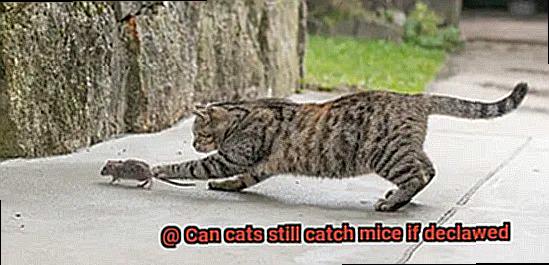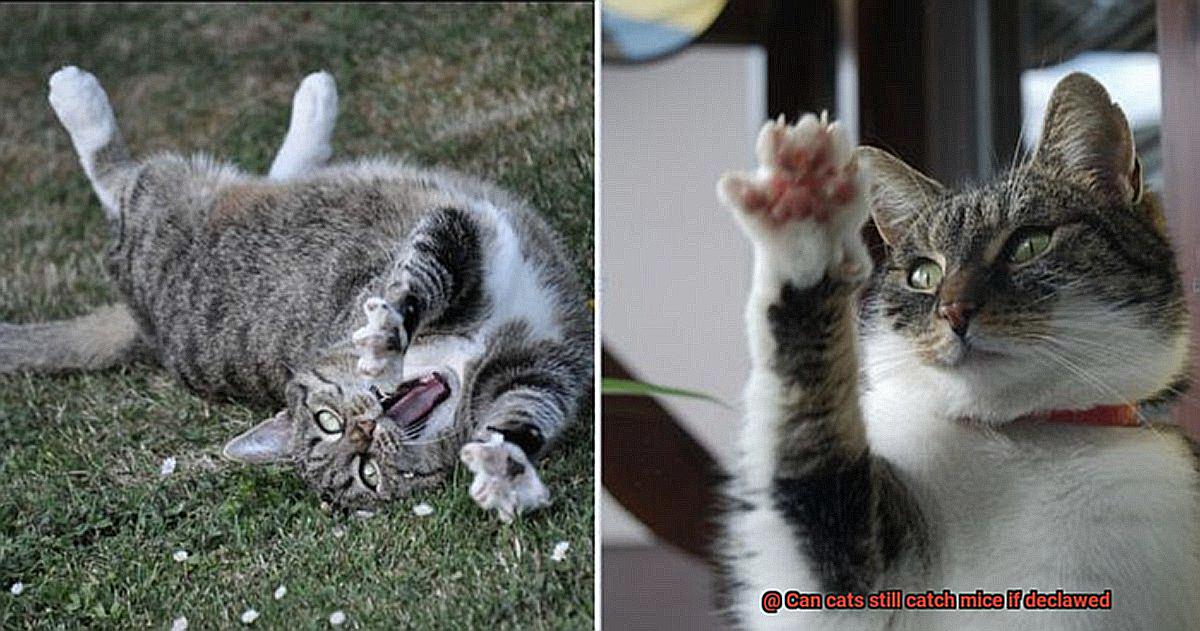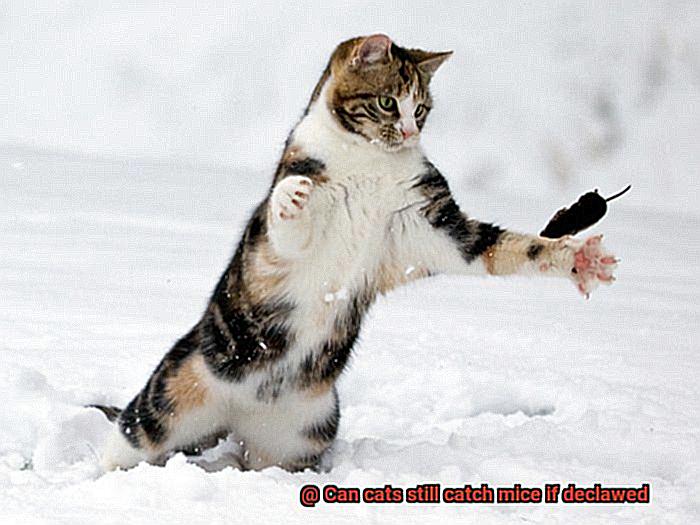Do you ever wonder if your declawed feline friend can still catch mice? You’re not alone. It’s a common question among cat owners. So, can cats still hunt mice if declawed? The answer may surprise you.
As a cat owner, you may have decided to declaw your pet for various reasons – scratching, destructive behavior, or even safety concerns. However, declawing can leave cats feeling vulnerable and uncomfortable. This procedure removes not only the sharp parts of the claw but also the entire digit, making certain activities like climbing or hunting a bit more challenging.
But fear not. Even though cats that have been declawed can no longer use their claws to catch prey, they still possess other innate instincts such as their sharp senses, stealth, and agility. They can rely on their teeth to catch prey or pounce on it with their paws.
However, there are potential risks involved when declawed cats hunt mice. We’ll discuss these later in the article. For now, let’s explore whether a declawed cat can still hunt mice and discover the facts together.
What is Declawing?
Although it may seem like a quick fix for furniture damage and scratches, declawing is a controversial practice that has been banned in several countries due to its negative impact on cats’ physical and emotional health.
Contrary to popular belief, declawing involves amputating the last bone of each toe rather than just removing the nail, making it an incredibly painful procedure. Moreover, it can lead to long-term complications such as chronic pain, behavioral issues, and arthritis. Declawed cats may also develop litter box issues and have difficulty walking properly.
Declawing is often done for the convenience of cat owners, but there are humane and effective alternatives available. Providing appropriate scratching surfaces and regular nail trimming are some examples of alternatives to declawing. It’s vital for cat owners to understand that declawing is not a necessary solution for scratching behavior and should not be taken lightly.
It’s important to prioritize your cat’s well-being above all else. Cats are natural hunters with instincts that go beyond their claws, so even without them, they can still hunt prey. Instead of declawing, cat owners should explore different solutions that are both safe and beneficial for their furry friends.
Do Cats Need Claws to Catch Mice?
Even declawed cats can still catch mice using their speed and agility.

You may be wondering how this is possible. Well, a study conducted by the University of California Davis found that declawed cats were just as successful at catching mice as cats with their claws intact. Both groups of cats were released into a field with a high mouse population, and both sets of cats were able to catch mice at similar rates. This goes to show that cats are natural predators and their hunting instincts are ingrained in their DNA.
It’s essential to note, however, that declawed cats may be more vulnerable in certain situations. Without claws, they may not be able to defend themselves as effectively against other animals or escape from dangerous situations. That being said, owners of declawed cats should take extra precautions to keep their pets safe and avoid situations where they may be at risk.
How Can Cats Catch Mice Without Claws?
Cats are legendary hunters and chasing mice is just what they do. But what if a cat doesn’t have claws? Can they still catch their prey? The answer is yes, they can.
Even though declawed cats may have lost their primary hunting tool, they’re still natural predators. They have other senses like their sense of smell and hearing that they use to locate their targets. Once they’ve spotted their prey, they use their teeth to bite and grab the target, and their paws to pin it down.
However, declawed cats may not be as swift at climbing or jumping as those who have claws. This can put them at a disadvantage in some hunting situations.
As a cat owner, there are things you can do to help your declawed cat catch mice. Providing toys that stimulate their hunting instincts, such as small stuffed animals or toys that move like prey, can be beneficial. You can also set up a safe and secure outdoor enclosure where your cat can practice their hunting skills.
It’s crucial to keep in mind that declawing is a contentious practice that can negatively affect a cat’s physical and emotional well-being. If you’re considering declawing your cat, it’s best to explore alternative options and consult with your veterinarian.
Are Declawed Cats at a Disadvantage When Hunting Mice?
Unfortunately, the answer is yes. Declawing has a significant impact on a cat’s ability to hunt effectively.
Cats rely on their claws as essential tools for hunting. Without them, catching and killing prey becomes a challenge. Declawing involves the surgical removal of these tools, which causes pain and discomfort for the cat. The procedure can also alter a cat’s gait, making it harder for them to move stealthily and pounce on prey. As a result, declawed cats may struggle to catch mice.
Declawing can also affect a cat’s behavior. Some declawed cats may be hesitant to engage in hunting behavior due to discomfort or fear of injury. This can further impact their ability to catch mice.
However, owners can help their declawed cats maintain their natural hunting instincts and improve their abilities with practice and training. Toys and games that simulate hunting behavior, such as chasing a toy mouse or feather wand, can help declawed cats practice and improve their skills.
It’s crucial to remember that declawing is a contentious practice that can negatively affect a cat’s physical and emotional well-being. Regular nail trimming and providing scratching posts are effective alternatives that prevent damage to furniture and other household items without resorting to declawing.

Is It Better to Leave a Cat’s Claws Intact?
My answer is an emphatic no. There are several reasons why this surgical procedure should be avoided at all costs.
Firstly, declawing is a major surgery that involves amputating the cat’s toes up to the first joint. This can cause serious physical and emotional consequences such as pain, infection, and behavioral issues. It’s simply not worth putting your cherished pet through such trauma.
Secondly, cats use their claws for many essential functions such as hunting, climbing, self-defense, marking territory, stretching their muscles and grooming themselves. Removing their claws severely limits their ability to perform these natural behaviors. It’s similar to taking away a chef’s knives – it significantly impairs their ability to cook.
Thirdly, there are many alternatives to declawing that can be just as effective in managing unwanted behaviors. You can provide appropriate scratching surfaces, use deterrent sprays or double-sided tape, and trim your cat’s nails regularly to prevent destructive behavior.

Lastly, leaving a cat’s claws intact is simply more compassionate. It respects their natural needs and behaviors and prevents potential physical and emotional problems down the road.
Alternatives to Declawing
However, when it comes to declawing, it’s important to know that this practice is not only cruel but can also have long-lasting effects on your cat’s physical and mental health. Luckily, there are several safe and humane alternatives to declawing that can help prevent damage to furniture and other household items while keeping your cat happy and healthy.
One of the best alternatives to declawing is providing your cat with appropriate scratching surfaces. Cats need to scratch to maintain healthy claws, so giving them a designated scratching post or pad can redirect their scratching behavior. It’s crucial to select a scratching surface that your cat enjoys, whether it be a vertical or horizontal surface, and place it in an area where your cat spends a lot of time. By doing this, you’re offering your cat a natural outlet for their behavior while saving your furniture from damage.
Another excellent alternative is nail trimming. Regular nail trims can help prevent damage to furniture and other household items while keeping your cat’s claws at a healthy length. It’s essential to use proper techniques and tools when trimming your cat’s nails to avoid injuring them. You can quickly learn how to trim your cat’s nails at home or take them to a groomer for professional services.
Soft Paws or nail caps are another fantastic option for cat owners who want to protect their furniture without resorting to declawing their cats. These small plastic caps are glued onto your cat’s nails, covering the sharp tip of the claw. While they may take some getting used to for your cat, they’re safe and effective in preventing damage to household items.
Finally, behavior modification techniques can be used to deter your cat from scratching furniture. Positive reinforcement training can teach your cat to scratch appropriate surfaces while avoiding inappropriate ones. Additionally, using deterrent sprays or double-sided tape on furniture can discourage your cat from scratching in those areas.
Conclusion
After careful consideration, it’s clear that declawing cats is not a viable solution for scratching and destructive behavior. The procedure involves removing the last bone of each toe, resulting in pain, discomfort, and long-term complications that can affect a cat’s physical and emotional health.
But what about catching mice? Can declawed cats still rely on their natural instincts as predators? The answer is yes – while they may be more vulnerable in certain situations without their claws, declawed cats can still use their speed, agility, teeth, and paws to catch prey.
However, it’s important for owners to take extra precautions to keep their pets safe and avoid risky situations. Providing toys that simulate hunting behavior and setting up a safe outdoor enclosure can help declawed cats practice and improve their skills.
Rather than resorting to declawing, there are several alternatives that prevent damage to furniture and other household items while keeping your cat happy and healthy. These include providing appropriate scratching surfaces, regular nail trimming, using Soft Paws or nail caps, and behavior modification techniques.
Ultimately, leaving a cat’s claws intact is the most compassionate choice that respects their natural needs and behaviors.

